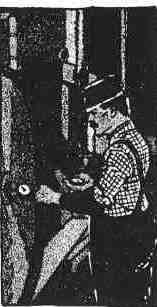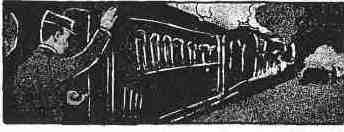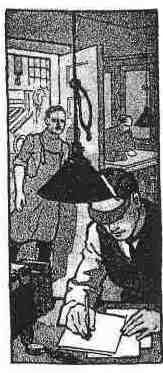Hamilton Watch Company’s business went through several phases. The Company proved its resilience by responding to the market demand of different eras. When the railroads began their massive expansion in the US, Hamilton responded and loaded their pockets with gold. The Company used this as the primary advertising and marketing piece.
Railroad Timekeeper of America Booklet
The most important function of a watch is to keep time.
A watch is incidentally valuable as an ornament, as jewelry, as a possession of real, tangible, cash-able value.
But its primary purpose is to tell the time, and it follows quit: naturally that the more reliable a watch is as a timekeeper, the: more valuable it is as a watch.
The best watch, then, is the one which is the most dependable timekeeper.
Nobody really prefers a poor watch to a good one, and nobody who can own a watch will choose to get along without one.
Some men are required by ‘the exigencies of their business to carry watches that are remarkably accurate. With such men correct time is the most important factor in their lives. The mere idea that their watch was “OFF” by gaining or losing to an unreasonable extent, would be so disquieting that they could not do their best work.
 Yet men of this class — railroad and professional men, navigators. engineers and men engaged in scientific research work, etc —are only a small per cent. of the enormous number of people who want absolutely accurate time.
Yet men of this class — railroad and professional men, navigators. engineers and men engaged in scientific research work, etc —are only a small per cent. of the enormous number of people who want absolutely accurate time.It is not the value of time that makes people want their watches accurate. No matter how much money per minute the time of a business man might be worth, he would lose nothing in by having a watch that was three seconds fast. The mason for wanting an accurate timekeeper strikes deeper than that. For a watch actually has a direct psychological effect on the individual who carries it.
The old custom of presenting a youth approaching maturity with a watch is a good one—not because it “teaches him the value of time,” but because it gives him a companion with qualities so admirable that he would do well to emulate them.
There is undoubtedly a closer relationship between a man and his watch than between man and any other inanimate object. He carries it in his pocket day after day and year after year. Many a man sleeps with his watch under his pillow. It is the last thing he sees at flight and the first thing he looks at in the morning. Hardly any important step is taken at any time during the day or night without first consulting his watch. All men are more or less methodical, and the tendency of every man is to live by his watch. Sentiment quickly attaches itself to such a possession.
What then is more natural than for a man to want his watch to be not merely fairly accurate, but very accurate? A reliable watch may not always mean a reliable man, but it certainly does mean that a man who carries such a watch admires reliability and desires that quality in the things with which he is associated.
All jewelers and watchmakers have met that type of man known as the “time crank.” The “time crank” becomes irritated if his watch picks up or loses as much as five seconds per week while positions of the greatest importance permit a variation of 20 seconds per week. There are some people who cannot understand how he would know that his watch was off five seconds. Here is how closely the “time crank” watches his time. In the first place, he takes his watch to a jeweler and has it set right to the second — something which it is always safer to let a jeweler do. When the hands of his watch are set to points exactly at, say, twelve o‘clock, the seconds hand is moved around to the top also, so that it points to “60.”
The watch is started with all hands exactly in place. Mr. “Time Crank” generally ties himself to his jeweler and compares time. If he finds too great a variation he demands that his watch be more closely adjusted. It is an interesting fact that most “time cranks” seam to gravitate to the possession of a Hamilton Timekeeper.
However, not all of us have the time to be “time cranks.” Generally the “time crank” is not a man in whose life a second amounts to any prominent value. More often he is an old man retired from active business, but always be is the man whose “word is as good as his bond.”
Nevertheless, we want our watches to be so accurate that it will not be necessary to be constantly confirming their time; or like the watch which Captain Cuttle gave to “Wal’r Gay,” “Set her up fifteen minutes in the morning and another twenty minutes along in the afternoon, and it’s a watch that’ll do you credit.”
 The Hamilton Timekeeper was originally a railroad watch made for use of railroad men. The first Hamilton Timekeeper was begun in the early spring of the year and completed later in the fall of the same year. The fourth Hamilton Timekeeper to be made was purchased by Mr. Edwin Paul, a conductor on the Pennsylvania Railroad, and if you were to ride from Philadelphia to Harrisburg, Pa., today on Mr. Paul‘s train, you would be running on the time of that same Hamilton keeper.
The Hamilton Timekeeper was originally a railroad watch made for use of railroad men. The first Hamilton Timekeeper was begun in the early spring of the year and completed later in the fall of the same year. The fourth Hamilton Timekeeper to be made was purchased by Mr. Edwin Paul, a conductor on the Pennsylvania Railroad, and if you were to ride from Philadelphia to Harrisburg, Pa., today on Mr. Paul‘s train, you would be running on the time of that same Hamilton keeper.The growth of the popularity of the Hamilton Timekeeper as a railroad watch was in a direct ratio to the tendency of railroads to run trains on a closer schedule of time.
From two or three minutes to twelve, or two or three minutes after twelve, passing fairly well for
 twelve o‘clock, the variance contracted to a matter of minutes and fractions of a minute. Where trains were once run five minutes or more apart, they are now run two minutes apart and sometimes less. Today trainmen figure down to the seconds in timing their runs. And the railroad man‘s watch that gains or losses as much as three or four seconds per day is in danger of being “condemned” by the authorized Watch Inspector and ordered out of service for readjustment.
twelve o‘clock, the variance contracted to a matter of minutes and fractions of a minute. Where trains were once run five minutes or more apart, they are now run two minutes apart and sometimes less. Today trainmen figure down to the seconds in timing their runs. And the railroad man‘s watch that gains or losses as much as three or four seconds per day is in danger of being “condemned” by the authorized Watch Inspector and ordered out of service for readjustment.The Hamilton Timekeeper became more and more favored among railroad man neither by advertising nor by aggressive selling methods, but because in every group of trainmen, the men who carried Hamilton Watches gradually became the authority on time and other men set their watches by Hamilton time. Quite naturally when one of these other men got ready to buy a watch, he remembered the name “Hamilton” on the watch which he had begun to recognize as the standard timekeeper, and so he bought a Hamilton. In this way it became known as “The Railroad Timekeeper of America” and to-day 56 percent of the railroad men of America carry Hamilton Timekeepers.
 Until comparatively recent years, railroad men took almost the entire output of Hamilton Watches, but every year the general public began to take more Hamilton Timekeepers. Jewelers were of course, acquainted with the Hamilton, and a great many jewelers began to carry Hamilton Timekeepers for their personal use. Then often when some man insisted that he wanted an unusually good watch, his jeweler would recommend the Hamilton Timekeeper. Men who you would think had no real use for a phenomenally correct and precise watch began to buy the Hamilton, and it soon developed that a large part of the general public was just as particular about railways having the right time as anybody else.
Until comparatively recent years, railroad men took almost the entire output of Hamilton Watches, but every year the general public began to take more Hamilton Timekeepers. Jewelers were of course, acquainted with the Hamilton, and a great many jewelers began to carry Hamilton Timekeepers for their personal use. Then often when some man insisted that he wanted an unusually good watch, his jeweler would recommend the Hamilton Timekeeper. Men who you would think had no real use for a phenomenally correct and precise watch began to buy the Hamilton, and it soon developed that a large part of the general public was just as particular about railways having the right time as anybody else.Now it’s just as practicable to make an accurate small American watch as it is to make a dependable large watch. By “American watch” is meant a watch made by American methods. American matchmaking considerably from Continental watchmaking in that not only is every piece of the watch made by machinery, but the very machines which make the parts are also machine-made and are so closely adjusted that a variance of a 1/10,000 part of an inch is made practically impossible, as the extreme of accuracy is necessary for final adjustment and in order to have interchangeable parts.
For railroad use and similar purposes the larger watches are preferred, not because they admit of any closer adjustment, but because they are built heavy and their larger dials with bold figures and large black hands enable one to determine the time more quickly at a greater distance from the eye especially in a dim light.
So that when the Hamilton Watch Company realized that the public was quite as much interested in the Hamilton Timekeeper as railroad men were, it was decided to make a Hamilton Watch with all the accuracy which the name Hamilton implies, but in a size and weight to meet the wishes of men in all walks of life; for their requirements we have constructed our 12- and 16-size watches.
A 12-size watch is about three-fourths as large as the 18-size, which is the size most generally in use among railroad and other technical men. The Hamilton 12-size is the thinnest 12—size watch made in America, and in the opinion of thousands of retail jewelers who are familiar with all kinds of watches, the Hamilton 12-size is the most phenomenally accurate timekeeper of its size.
A slightly larger timekeeper, the Hamilton 16-size —about midway in size between the “12″ and the “18” has been made for years, and is also immensely popular with men who work on close time schedules.
This 16-size was the Hamilton which, before and also since the advent of the l2-size, was so enthusiastically recommended by jewelers to customers who had sought their advice.
 The Hamilton 12- and 16-size Timekeepers are beautiful. They have the distinctive dial figures and the slim, aristocratic hands which make the Hamilton Timekeeper recognizable even before the name “Hamilton” is noted on the dial.
The Hamilton 12- and 16-size Timekeepers are beautiful. They have the distinctive dial figures and the slim, aristocratic hands which make the Hamilton Timekeeper recognizable even before the name “Hamilton” is noted on the dial.Hamilton Timekeepers are now made in twenty three grades, which embrace all sizes from the small Lady Hamilton to the 18-size, favored of railroad man; A complete, concise description of these watches will be found in the catalog section of this book—pages 31 to 45. (Not posted).
The difference between American watches and foreign makes, which has been touched on above, is worthy of a more extended exposition, as a knowledge of this kind is always worth something to the man who is considering the purchase of a watch.
In all Hamilton Timekeepers of the same size and grade the parts are interchangeable. This is not true of Swiss watches, because the individual work on each one precludes interchangeability. and makes satisfactory repairs very difficult and therefore very expensive. The Hamilton Timekeeper has this advantage not only over foreign watches, but also over most American makes.
The Hamilton watchmakers do not make low priced watches one day and fine timekeepers the next.
Every piece of work that is done is done well enough to pass an inspection that is always rigid— not flexible to admit the passing of inexpensive work.
This insures that each and every watchmaker is always doing his very best, because he knows that there is never occasion for cheap work in the Hamilton factory.
All their training is towards the manufacture and assembling of the best timekeepers possible to produce.
Expert watchmakers are as well known to the different watch factories as expert steel engravers are to the United States Secret Service Bureau. The man who can true a hairspring cannot hide his light under a bushel. There are only about twelve really good hair-spring truers in America, and more than half of these are working for the Hamilton Watch Company.
It takes from seven months to a year to make a Hamilton Timekeeper. The average time required is nine months. No watch is ever made in less than seven months, and two months of this time alone is consumed in the “assembling” or “finishing” room. Here all the more delicate parts are weighed on scales so delicate that they are made on the premises, no other scales being considered quite so trustworthy as those which the Hamilton Company make.
This is the text of a brochure published in 1911. It’s part of the public domain. No part of this document is copyrighted and no rights are reserved by me. It’s posted for educational purposes. Any images herein ( with the exception of one) were part of the original document.
Copyright 2006-2017 | All Rights Reserved




